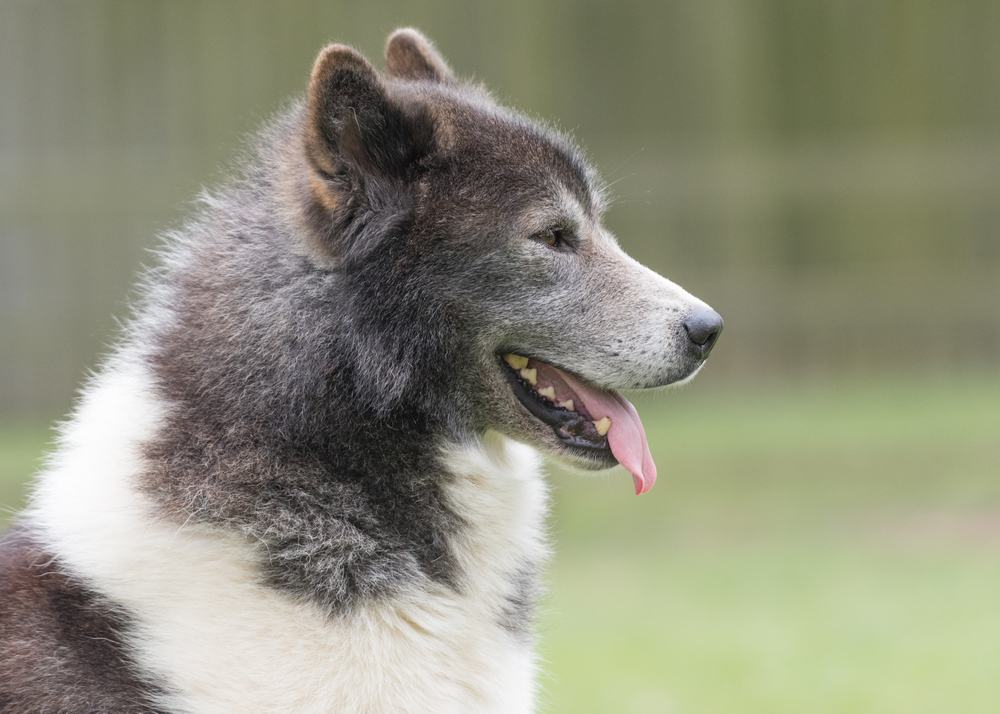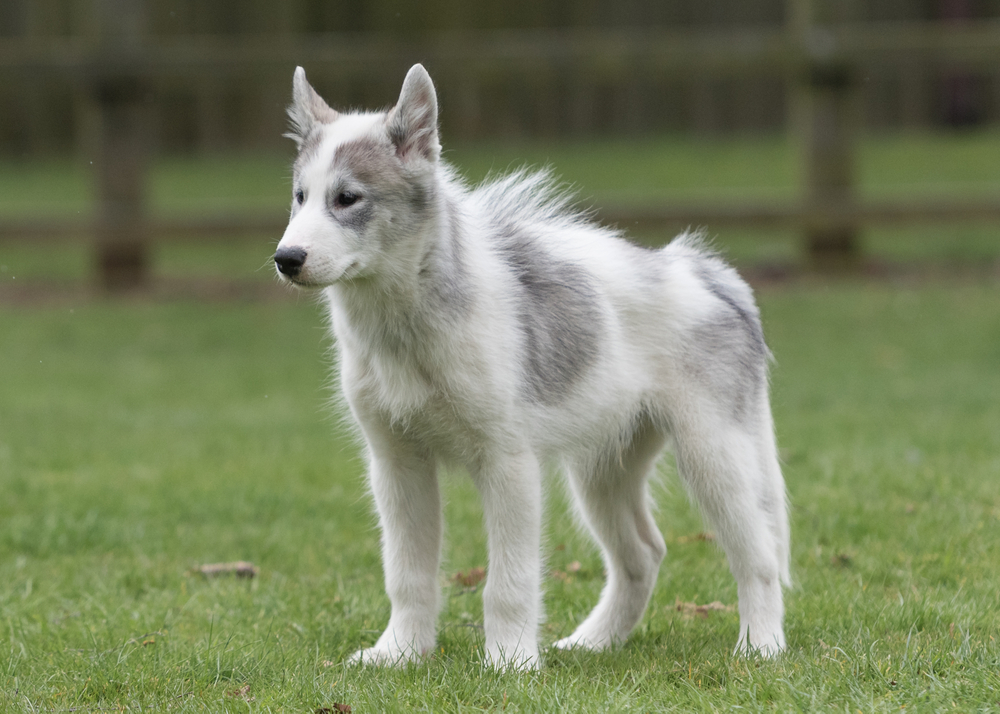In this article
View 8 More +As their name suggests, a Canadian Eskimo Dog is a working breed from the Arctic region of Canada. They’re traditionally used by the Inuit people for sled pulling and hunting. To survive in the frigid climate, they have thick fur and plenty of stamina.
Breed Overview
Height:
20–28 inches
Weight:
40–88 pounds
Lifespan:
10–15 years
Colors:
White, black, gray, brown, etc.
Suitable for:
Experienced dog owners with an active lifestyle
Temperament:
Intelligent, energetic, independent, alert
Sadly, these dogs almost went extinct in the late 20th century, largely due to government policies and the introduction of snowmobiles. However, conservation efforts have enabled this breed to make a comeback.
Despite this, Canadian Eskimo Dogs are not for everyone. As working dogs, they are exceptionally energetic and require plenty of stimulation. Otherwise, they can become quite destructive. They can also be stubborn at times, so they do best with an experienced dog owner who can properly train and care for them.
Canadian Eskimo Dog Characteristics

Canadian Eskimo Dog Puppies
Canadian Eskimo Dog puppies are energetic and curious. Now is the perfect time to start with early socialization and training. Puppies tend to be trusting and open, but these dogs can become more fearful as they get older. Therefore, introducing them to many people and places young can help prevent behavioral problems later.
Like all puppies, these dogs will go through a period of teething. Be prepared with chew toys, and take care to train your dog not to chew on the furniture or your favorite sneakers. Puppy training classes can help tremendously with training and socialization.
These dogs can be challenging to find, as they were almost extinct only a short time ago. You won’t typically find them at shelters, and rescues tend not to have them either. Therefore, you’ll need to search for a quality breeder and likely wait on a list for some time. Travel is often necessary, especially if you live beyond Canada.
Canadian Eskimo Dog Origin & History
Canadian Eskimo Dogs have a long history—one that we don’t know too much about. The first dogs probably arrived in the Americas around 12,000 years ago. However, people likely didn’t settle with dogs in the Arctic region until 4,500 to 1,000 years ago.
The Thule people likely brought the ancestors of the Canadian Eskimo Dog to the Arctic. This culture likely utilized the dogs for hunting and transportation, just like many people in that region do today. For millennia, these dogs played a crucial role in Inuit life.
However, the 20th century saw many shifts in the Inuit lifestyle, including the introduction of snowmobiles. Furthermore, government policies led to the slaughter and capture of many dogs, with the estimated number of dogs killed ranging from 1,200 to 20,000.1

Temperament & Intelligence of the Canadian Eskimo Dog 🧠
The Canadian Eskimo Dog is pretty unique, especially since they developed independently from many modern breeds. They’re highly trainable, thanks to their loyalty to their owners. However, they can also be independent.
These dogs are loving toward their families, forming strong bonds quickly. However, they can be aloof with strangers. They can make great watchdogs, as they tend to be alert to anything strange going on. If they see someone outside who isn’t supposed to be there, they will let you know.
Since they were bred to work, they retain their high energy level today. They need lots of physical and mental stimulation, or they may become destructive. We recommend them for experienced dog owners with plenty of time on their hands for these reasons.
Early socialization is vital to ensure these dogs are friendly (or at least not fearful) of strangers and other dogs.
Are These Dogs Good for Families? 🏡
Canadian Eskimo Dogs can be good companions for families, but it needs to be the right family, as they are quite active. For families with limited space or busy schedules, this can be challenging. They can also be independent, so it helps if you’ve trained a dog once or twice before. Clear, consistent training is crucial.
These dogs can also be aloof with strangers and even aggressive with other dogs. Proper training and socialization are necessary. If you have frequent visitors or young children, this may be even more of a concern. We recommend them mostly for experienced families who live an active lifestyle. Plan to devote plenty of time to these dogs, especially when they are younger and in need of socialization.

Does This Breed Get Along with Other Pets? 🐶 😽
Canadian Eskimo Dogs do not usually get along well with other pets, especially smaller animals. They have a strong prey drive, so they will see cats, rodents, birds, and other pets as prey animals. They may potentially harm them, even with extensive socialization and training.
They can get along with other dogs when properly supervised. However, their innate aloofness also carries over to strange dogs, so introductions need to be slow and careful. Early socialization and training can help your dog develop appropriate social behaviors.
Even with plenty of socialization, careful supervision is required.

Things to Know When Owning a Canadian Eskimo Dog
Food & Diet Requirements 🦴
These dogs do not have any particular dietary needs that set them apart from other dogs. A quality, commercial diet often works well.
Since Canadian Eskimo Dogs are often active, they may need a high-calorie formula. Look for dog food formulas designed for athletes if your dog exercises for more than an hour a day. Of course, adjust their serving sizes and food based on their body condition. If your dog is too heavy, lower their caloric intake. If they are losing weight, raise it.
These dogs don’t usually have issues digesting common dog food ingredients, despite some misconceptions. They may have been developed naturally in the Arctic, but they are not more “wild” than other breeds when it comes to their diet.
Of course, every dog is an individual. Therefore, it’s vital that you take your dog’s sensitivities and allergies into account when choosing a food. While these dogs are often pretty healthy, there are occasions when they may need special dog food. When in doubt, talk to your vet.

Exercise 🐕
Canadian Eskimo Dogs were bred for pulling heavy loads across vast distances. They were renowned for their high energy level and seemingly endless stamina. They carry these traits over to their lives today, despite being owned more and more as companion dogs. Expect this breed to be exceedingly active.
At a minimum, these dogs typically need at least 2 hours of daily exercise. Preferably, this exercise should vary. These dogs can become bored if they’re doing the same thing over and over again. Vigorous activities geared toward their natural pulling drive are ideal. Sledding, carting, and similar exercises are preferred. Implement training into these activities (such as through directional terms) to keep your dog’s mind sharp too.
Don’t forget to provide mental stimulation, especially if your dog isn’t doing anything particularly exciting or challenging during their physical exercise. Interactive toys, training, and puzzle feeders can also keep these dogs entertained, which is vital to their well-being and behavior.
These dogs can resort to destructive behaviors like chewing, digging, and barking if their exercise needs aren’t met.
Training 🦮
These dogs possess both intelligence and independence. Therefore, training can be a bit more complicated than for other breeds. It’s important that you start socializing your dog right away. Socialization helps build your dog’s confidence and prevents coming across new people as being scary. In the end, it helps your pup grow into a calm, confident adult.
We highly recommend puppy training classes. These teach the basic commands while also providing socialization in a controlled environment.
Utilize positive reinforcement training to get your dog’s “buy-in” for training. Otherwise, they may not listen. Focus on rewarding good behavior instead of punishing unwanted ones. Harsh punishments can damage your relationship, which only makes training more difficult. Be patient and consistent when training your canine. These dogs are independent, so repetition and positive reinforcement are absolutely necessary.
Before training sessions, exercise your Canadian Eskimo Dog well. Otherwise, they may be unable to focus and very distractible. Keep sessions very short and engaging, as they don’t have much of an attention span. Aim for several short sessions throughout the day instead of one long session.

Grooming ✂️
The Canadian Eskimo Dog has a thick coat that helps them withstand the harsh Arctic climate. Despite this, their coat isn’t actually that high maintenance. They do require grooming regularly. You should plan on brushing them at least once a week. Use a slicker brush and de-matting comb to remove any tangles they might have.
During the shedding season, daily brushing may be necessary to remove loose fur. Otherwise, your dog may end up shedding a bit too much, leading to tons of fur around your house and extra tangles in your dog’s coat. Always brush in the direction for the hair growth, starting from the head and slowly working your way down the back. Pay close attention to areas prone to matting, such as behind the ears and under the legs. You’ll want to use a comb to work through these tougher areas.
You do not need to bathe these dogs often. Overbathing can strip their coat of its natural oils and lead to irritation, even if you use a gentle shampoo. Only bathe your dog when it is absolutely necessary, such as when they are muddy or smelly.
You’ll need to trim their nails regularly too. If they get too long, they can cause pain and irritation. They may even split, leading to bleeding and potential infections. Check your dog’s ears weekly for signs of infection, such as redness and odor. While these dogs aren’t prone to ear infections, any dog can become affected, especially if their ears are left wet and dirty.
Health and Conditions ❤️
These dogs are generally pretty healthy. After all, they were bred primarily for work, and a sick working dog won’t do anyone much good. However, just like any breed, they can be prone to a health problem or two.
Like many large breeds, they can become affected by hip dysplasia. Simply put, this occurs when the dog’s hips don’t form properly, leading to excessive wear and tear. This condition isn’t curable, but it can often be managed with medication. In some cases, surgery may be required to repair the hip. In extreme cases, lameness can occur.
They can also develop a range of eye problems. Cataracts and entropion are the most common. Cataracts largely affect older dogs and lead to gradual vision loss. Entropion involves the eyelid turning inward, potentially damaging the cornea.
The Canadian Eskimo Dog can also develop gastric torsion, which is a life-threatening condition. When this condition occurs, the stomach twists and traps air, leading to tissue death. Emergency surgery is required within a few hours before tissue begins to die.
- Eye problems
- Allergies
- Cryptorchidism
- Bloat
- Degenerative myelopathy
- Hip dysplasia

Male vs. Female
Both sexes in this breed share many characteristics. However, there are notable differences between them. Firstly, males are much larger and more powerful than females. Males can weigh up to 88 pounds (or more, depending on who you ask). Females may weigh as little as 40 pounds.
Second, males may have a thicker coat, especially around their neck and head. This extra fur may create a “mane-like” appearance.
There aren’t any known temperament differences directly tied to sex beyond reproductive differences. These will dissipate if your dog is spayed or neutered.


3 Little-Known Facts About the Canadian Eskimo Dog
As you might guess, these dogs are closely related to several other breeds, including the Siberian Husky and Greenland Dog. You can notice the similarities between these breeds due to their shared ancestry and similar purposes.
2. Canadian Eskimo Dogs played a key role in Inuit life.
Canadian Eskimo Dogs pulled sleds for the Inuit people, but that isn’t all they did. They also assisted with hunting and providing warmth while sleeping. They even acted as guard dogs and watchdogs.
3. In the 20th century, these dogs were pushed very close to extinction.
These canines were almost extinct in the 20th century. There were several factors that played a role in this. For one thing, the introduction of modern machinery made it easier for the native people to get around in other manners, such as by using snowmobiles. The government also had several not-very-friendly sanctions against these dogs, which led to their slow extinction.

Conclusion
Canadian Eskimo Dogs are a native breed to the Arctic Circle, where they evolved next to people to pull sleds and assist with hunting. They’re a practical breed with thick fur to protect them from the harsh climates in their areas.
Due to their history as a working breed, they aren’t best for every family. They are incredibly active and intelligent, which leads to them being a lot of work. They’re a bit too intelligent at times and may second-guess their owners, causing them to disobey commands. Consistent training is required, on top of at least 2 hours of exercise a day.
All of this adds up to lots of time required on the owner’s part. Otherwise, they can become destructive, chewing up furniture and digging holes.
Featured Image Credit: Karen Appleby, Shutterstock


















